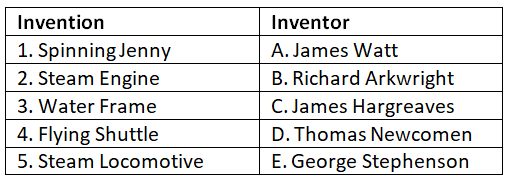Worksheet: Industrial Revolution | General Knowledge Encyclopedia - Class 8 PDF Download
| Table of contents |

|
| Section A: Multiple Choice Questions (MCQs) |

|
| Section B: Short Questions |

|
| Section C: Fill in the Blanks |

|
| Section D: True or False |

|
| Section E: Match the Column |

|
Section A: Multiple Choice Questions (MCQs)
Q1: When did the Industrial Revolution begin?
(a) 18th century
(b) 15th century
(c) 19th century
(d) 16th century
Q2: Which industry marked the starting point of the Industrial Revolution?
(a) Textile
(b) Agriculture
(c) Mining
(d) Transportation
Q3: What invention made weaving cloth easier during the Industrial Revolution?
(a) Spinning Jenny
(b) Cotton Gin
(c) Flying Shuttle
(d) Steam Engine
Q4: Why did many people move from rural areas to cities during the Industrial Revolution?
(a) To find better agricultural opportunities
(b) To escape crowded cities
(c) To seek better job prospects in factories
(d) To avoid labor unions
Q5: Which group of workers advocated for better working conditions during the Industrial Revolution?
(a) Factory owners
(b) Industrialists
(c) Labor unions
(d) Farmers' associations
Section B: Short Questions
Q1: Describe the impact of the Industrial Revolution on cities and urban areas.
Q2: How did the introduction of machines affect the production and cost of goods during the Industrial Revolution?
Q3: What were some of the challenges faced by factory workers in terms of working conditions and wages?
Q4: Explain the role of labor unions during the Industrial Revolution and how they contributed to improving workers' rights.
Q5: Discuss two significant inventions that revolutionized the textile industry during the Industrial Revolution.
Section C: Fill in the Blanks
Q1: The Industrial Revolution began in ___________ during the late 18th century.
Q2: The invention of the ___________ was a crucial development during the Industrial Revolution.
Q3: The shift from hand production to machines led to the growth of ___________ industries.
Q4: The spinning jenny was invented by ___________.
Q5: The Industrial Revolution resulted in a significant rise in ___________.
Section D: True or False
Q1: The Industrial Revolution mainly occurred in the 16th century.
Q2: The use of steam power in factories increased productivity.
Q3: Handicrafts and cottage industries declined during the Industrial Revolution.
Q4: The spinning jenny was used in the cotton industry.
Q5: The Industrial Revolution only had positive impacts on society.
Section E: Match the Column

You can access the solutions to this worksheet here.
|
30 videos|108 docs|27 tests
|
FAQs on Worksheet: Industrial Revolution - General Knowledge Encyclopedia - Class 8
| 1. What is the Industrial Revolution and why is it significant? |  |
| 2. What were the main inventions during the Industrial Revolution? |  |
| 3. How did the Industrial Revolution impact workers and labor conditions? |  |
| 4. What role did the Industrial Revolution play in urbanization? |  |
| 5. How did the Industrial Revolution affect global trade? |  |



















